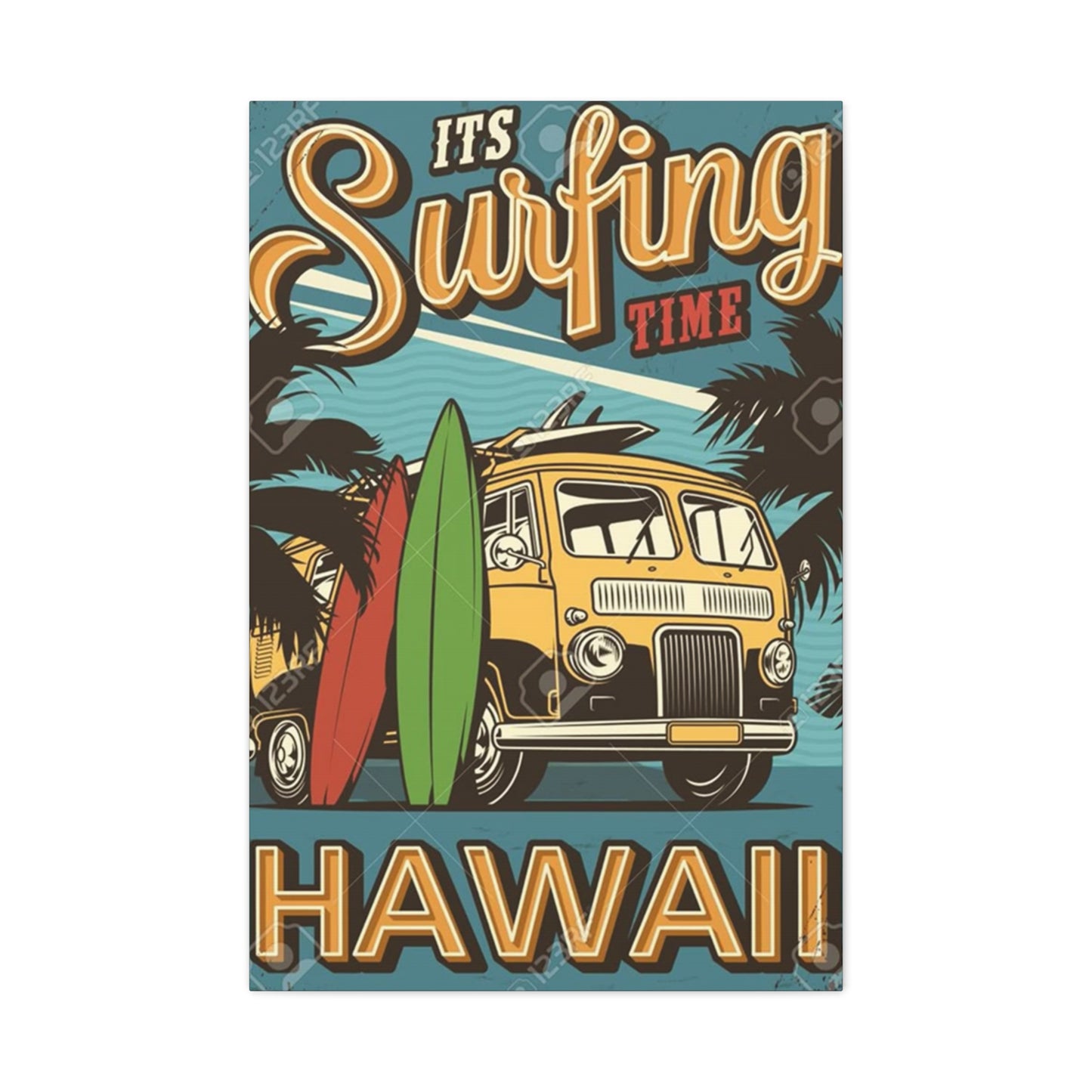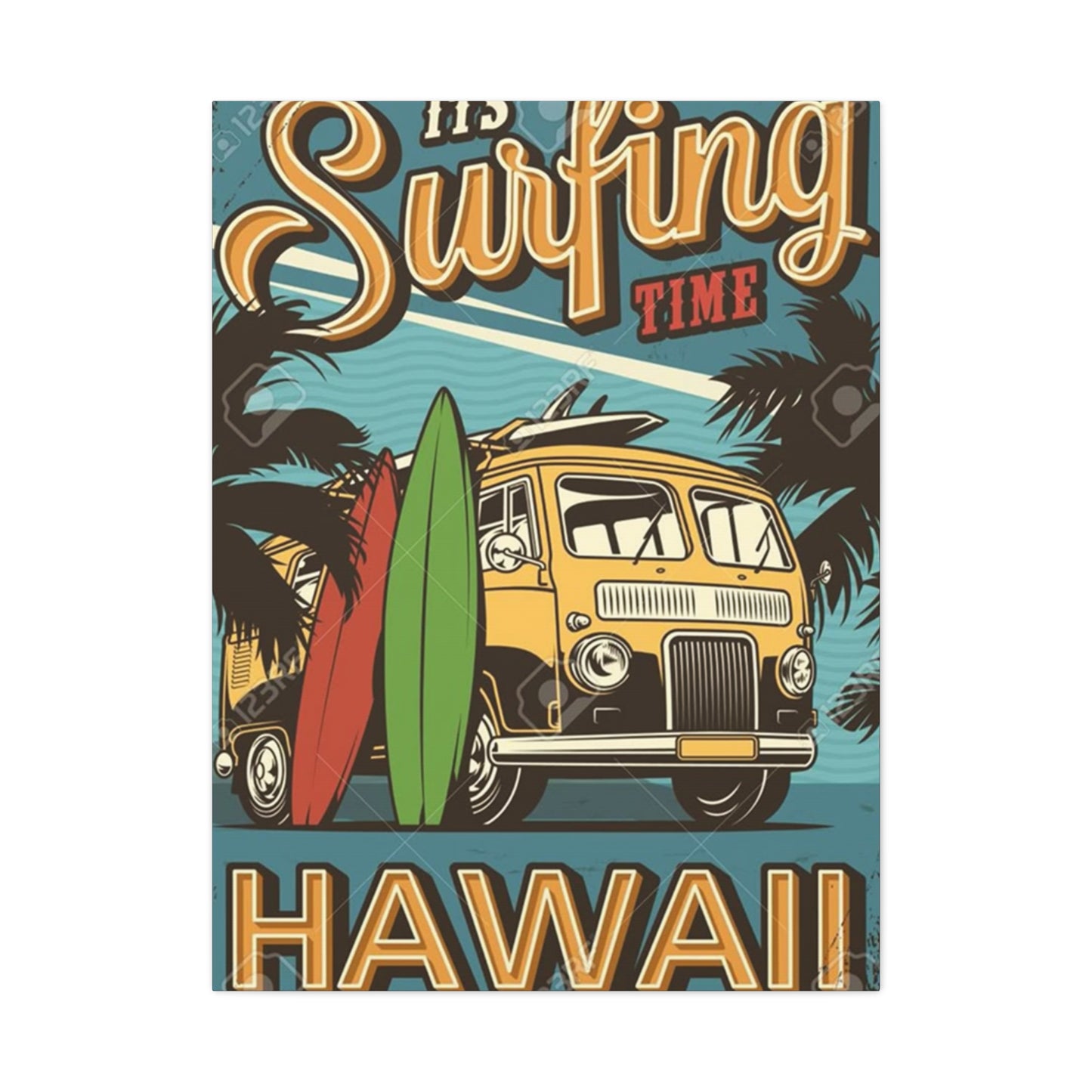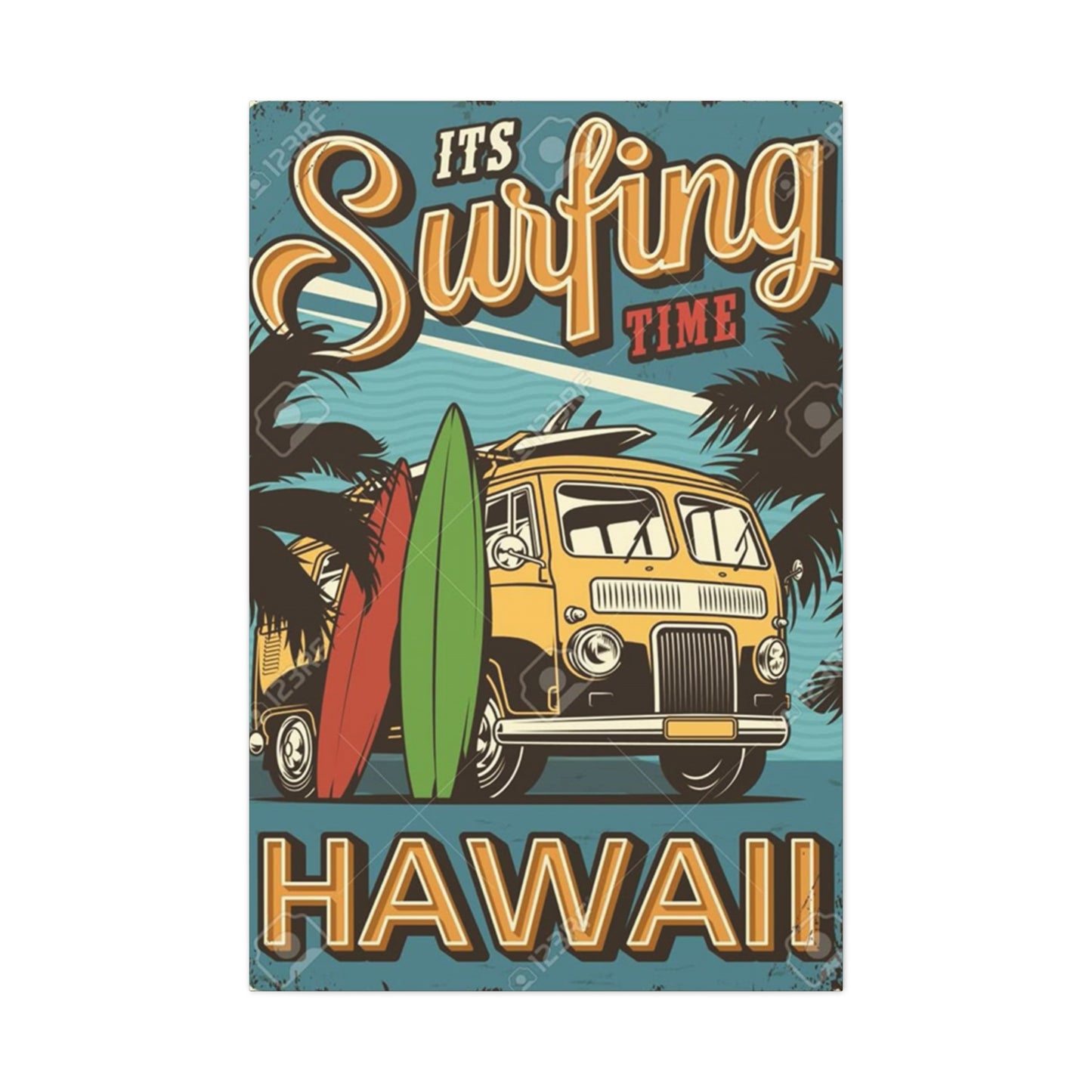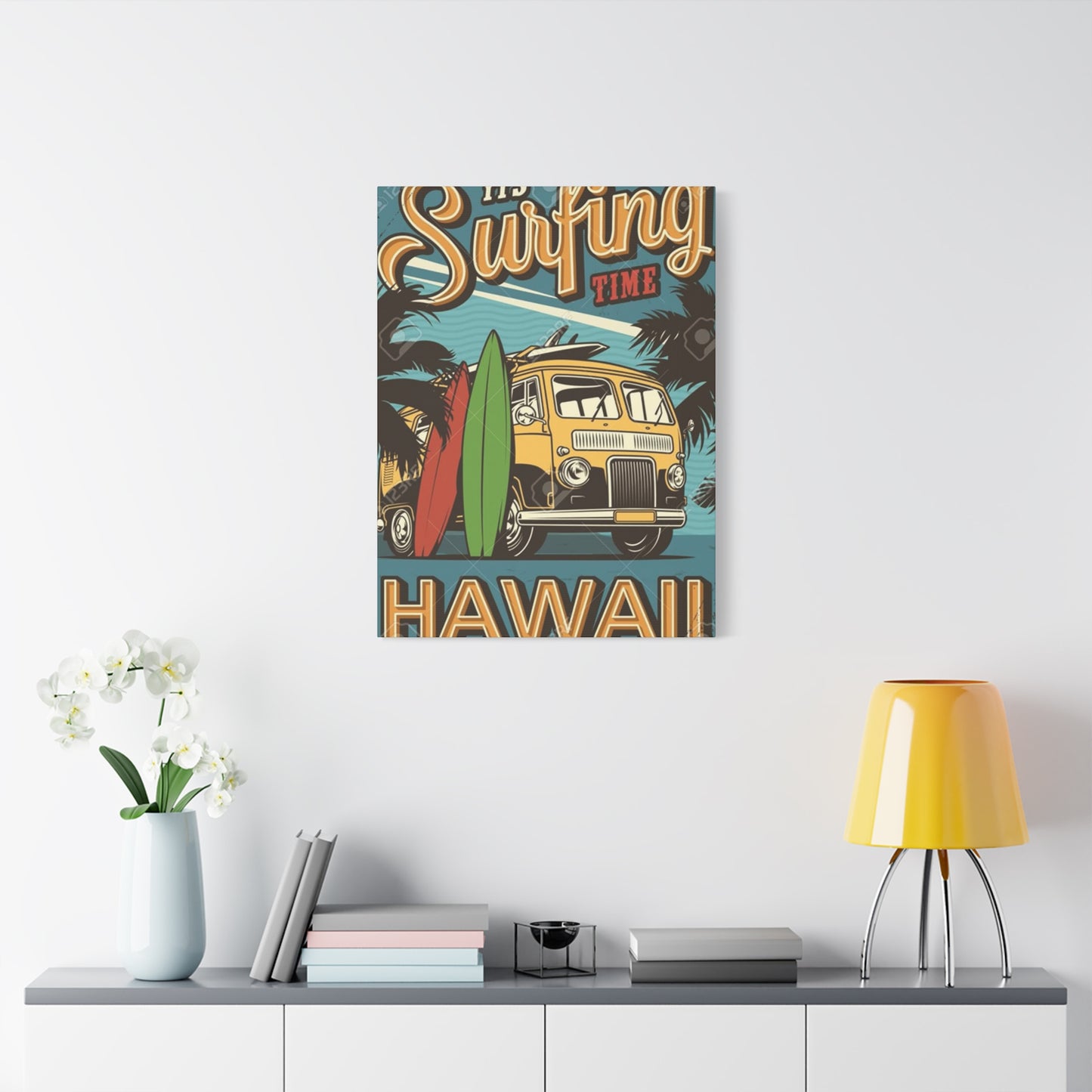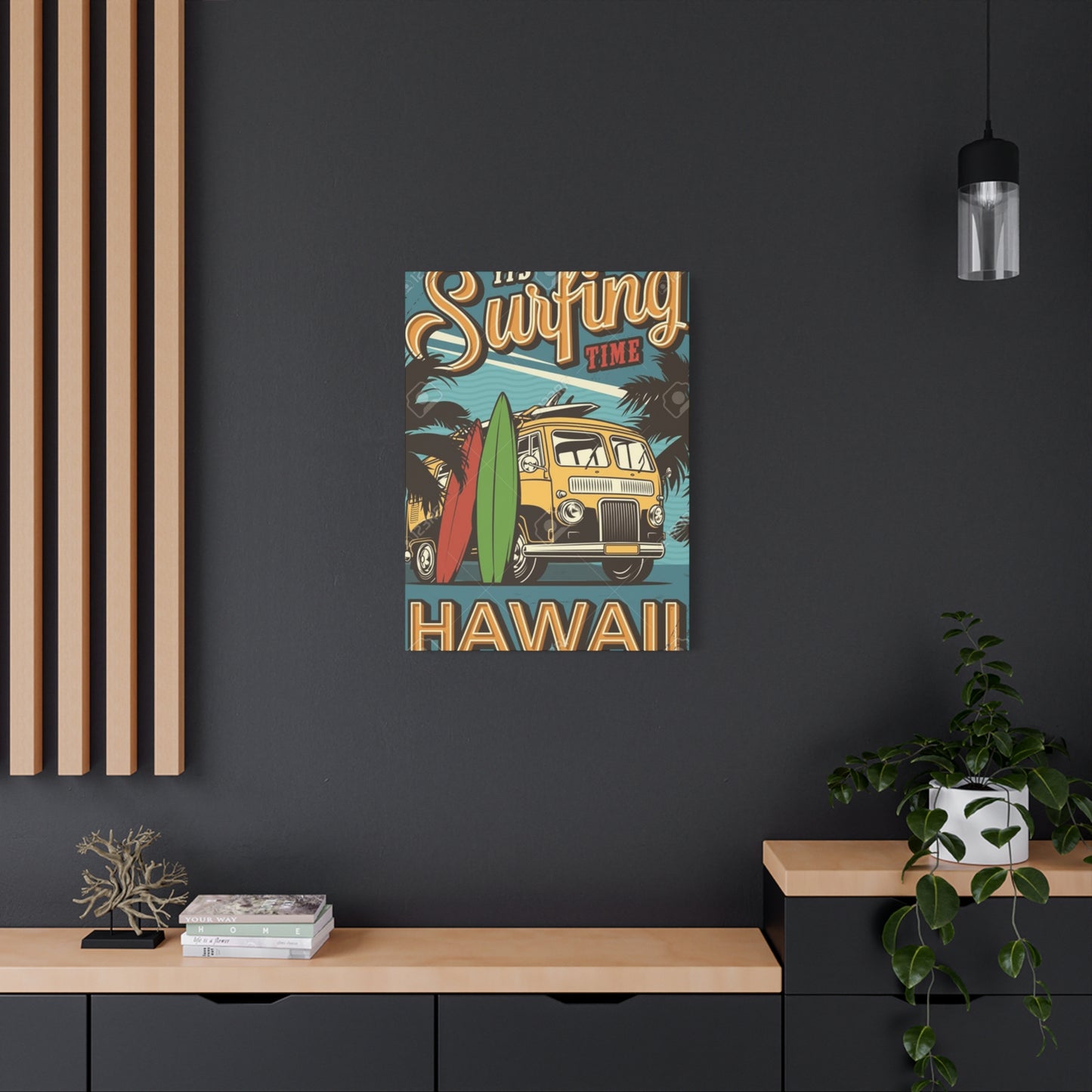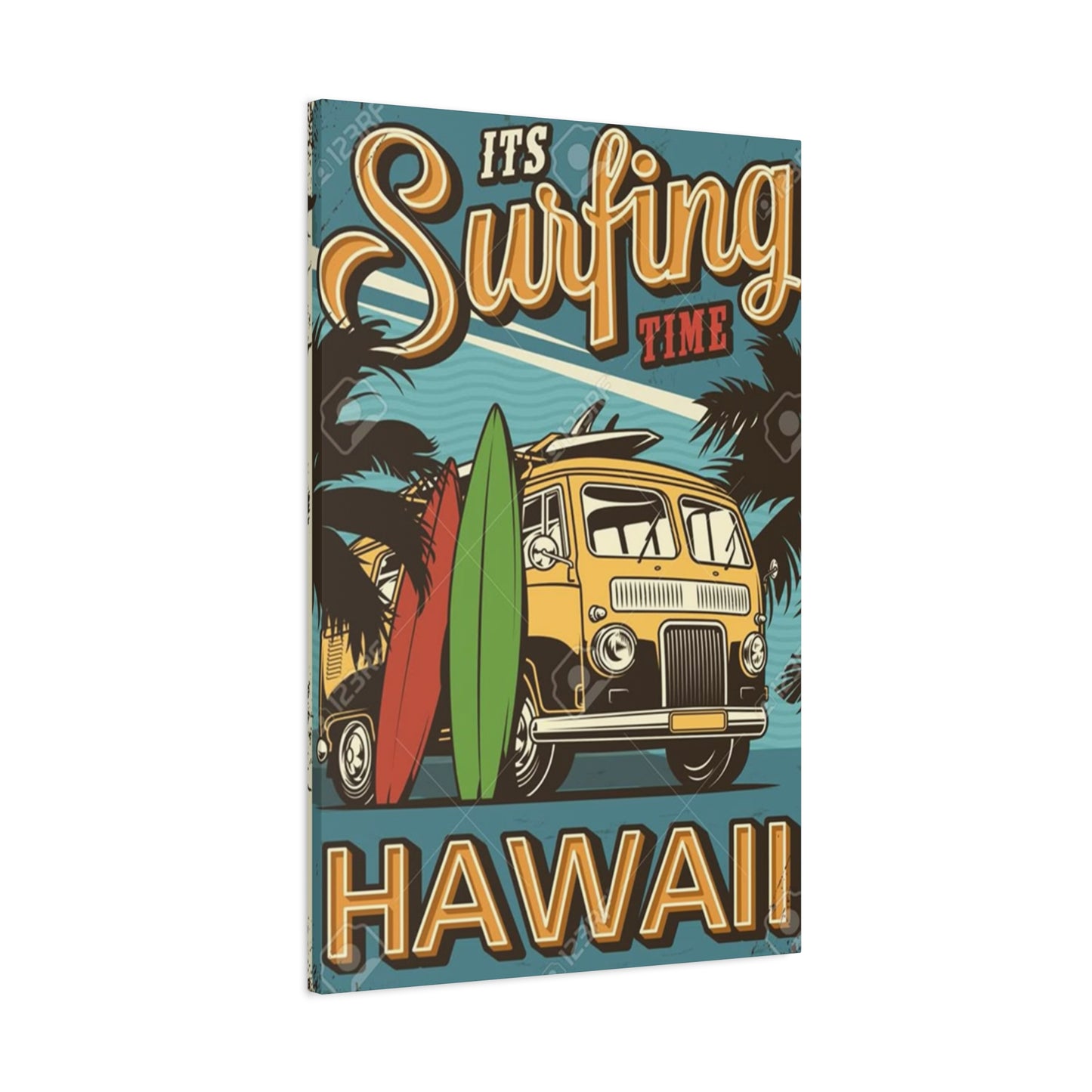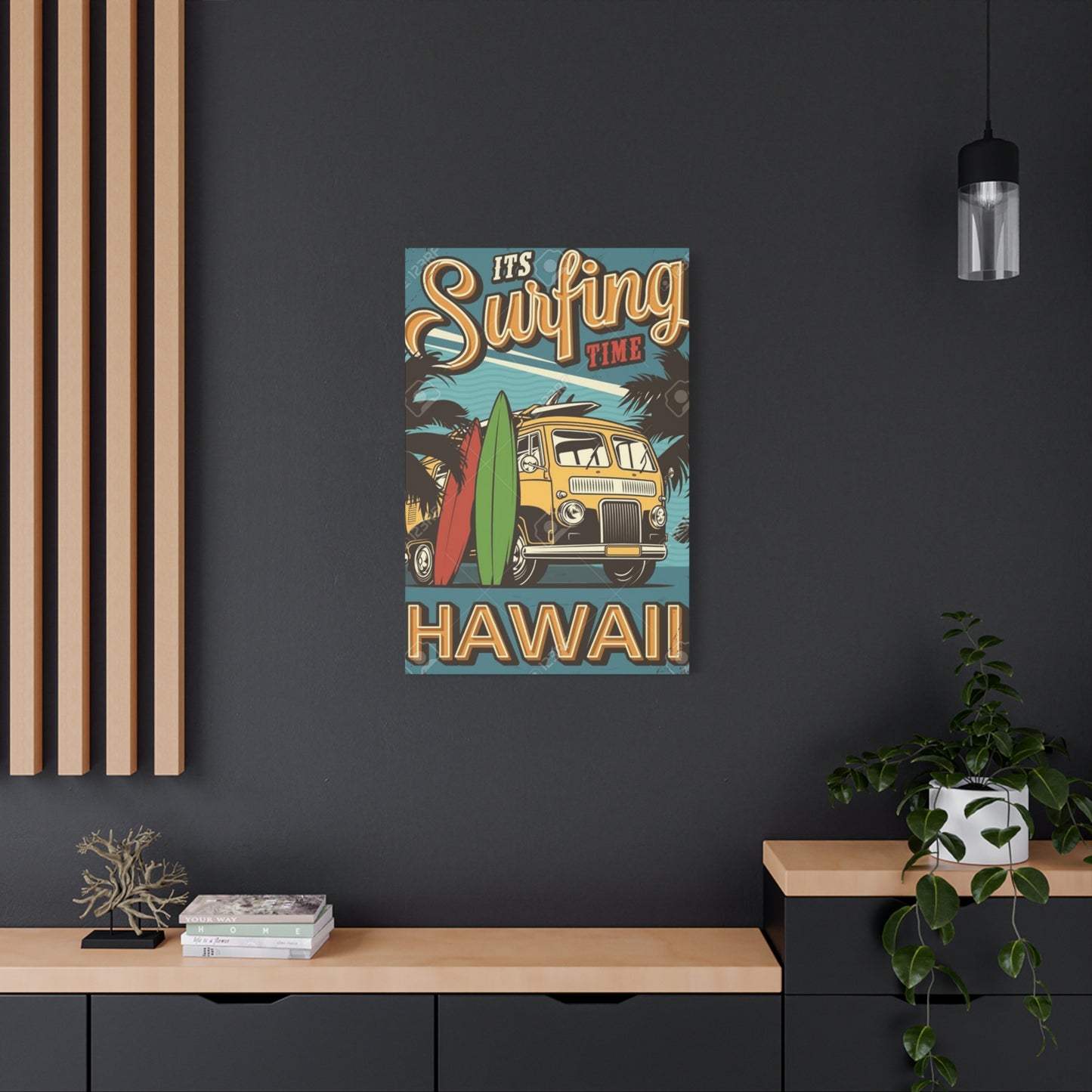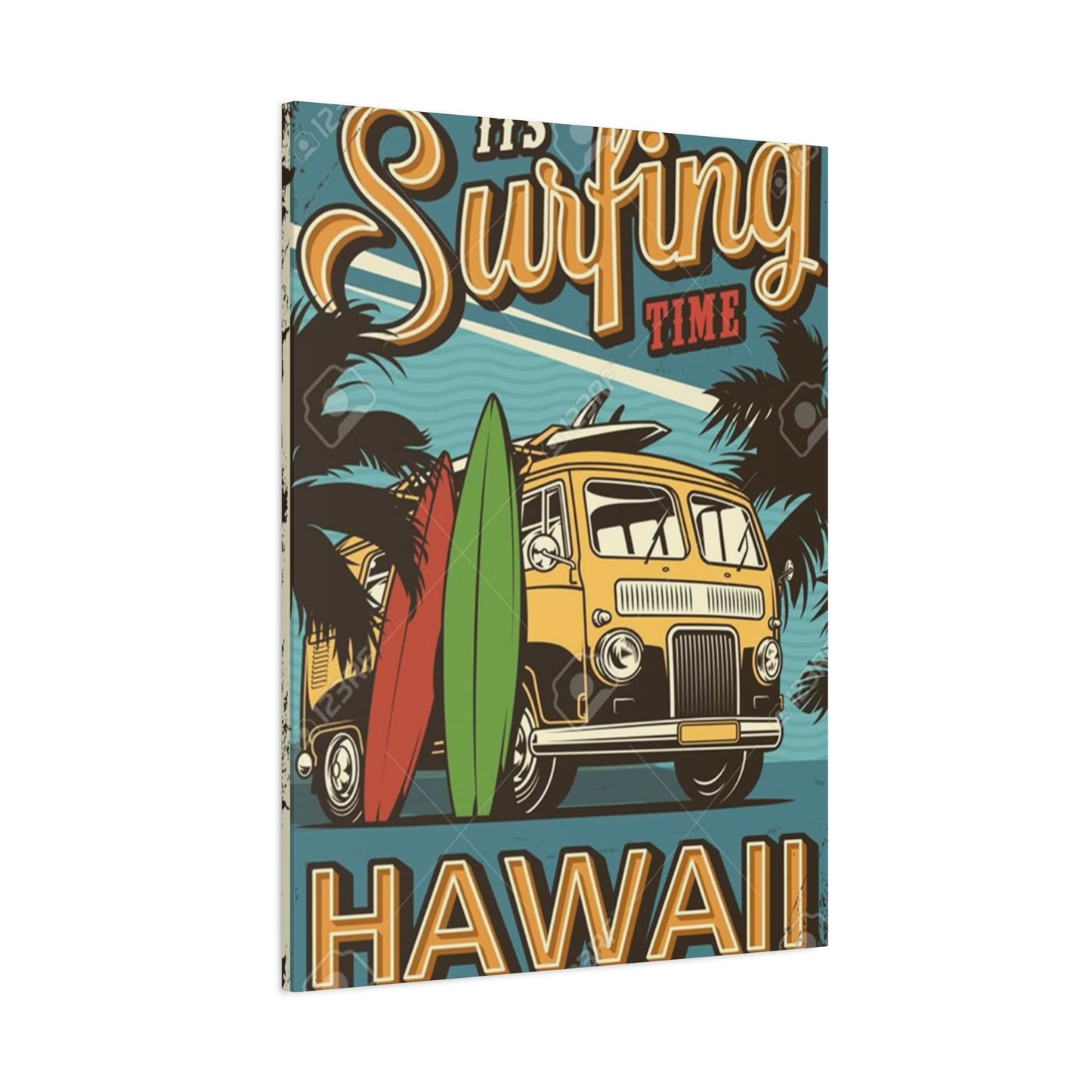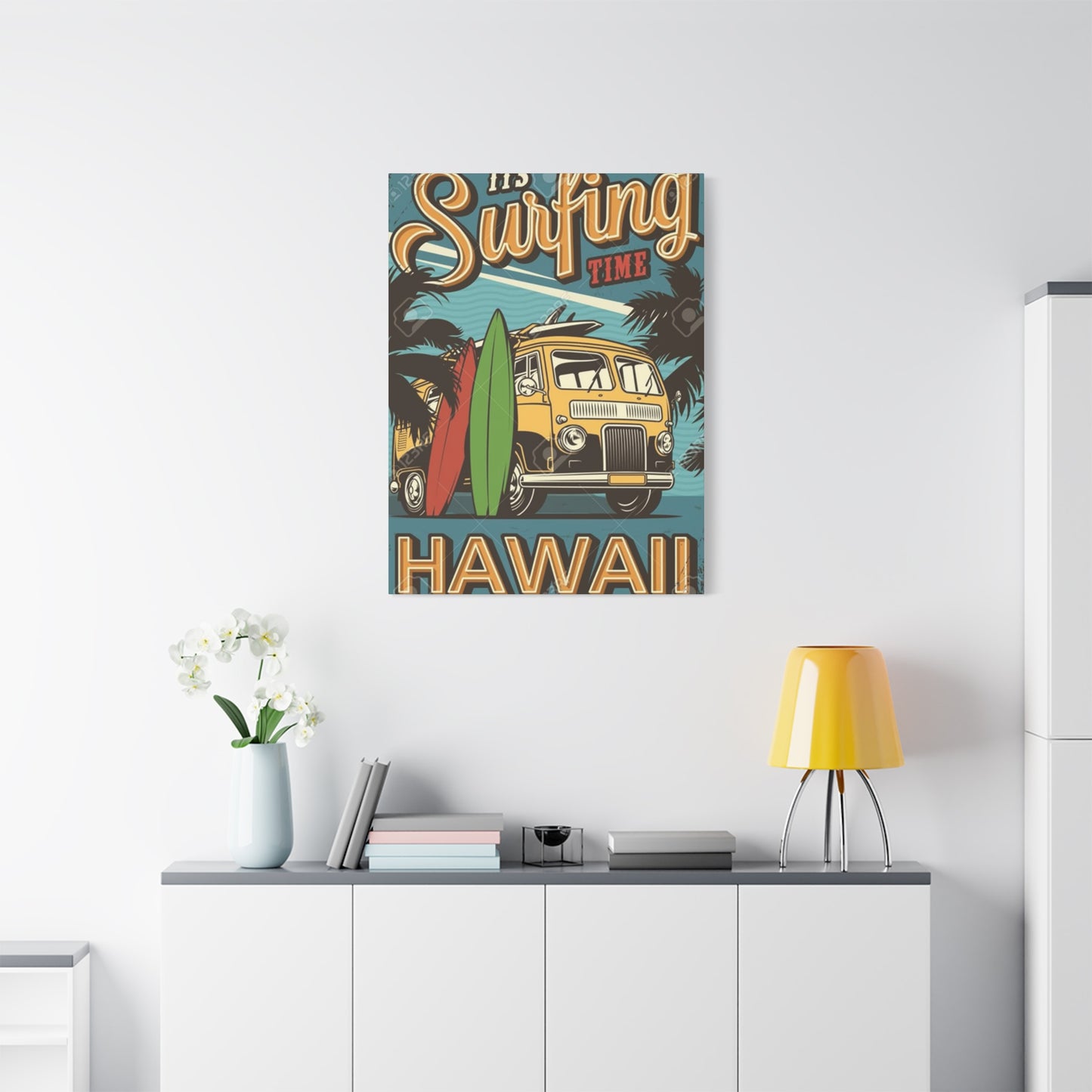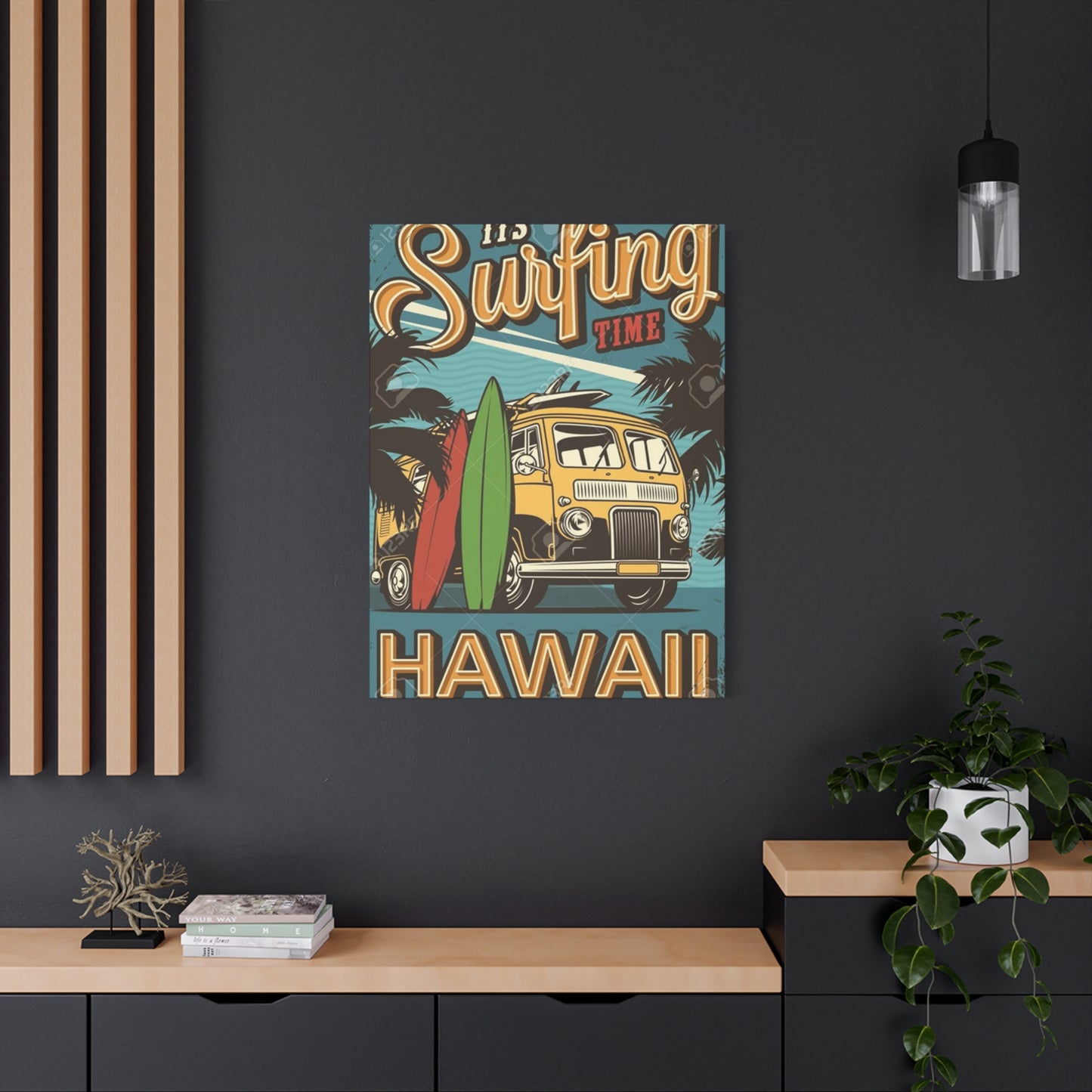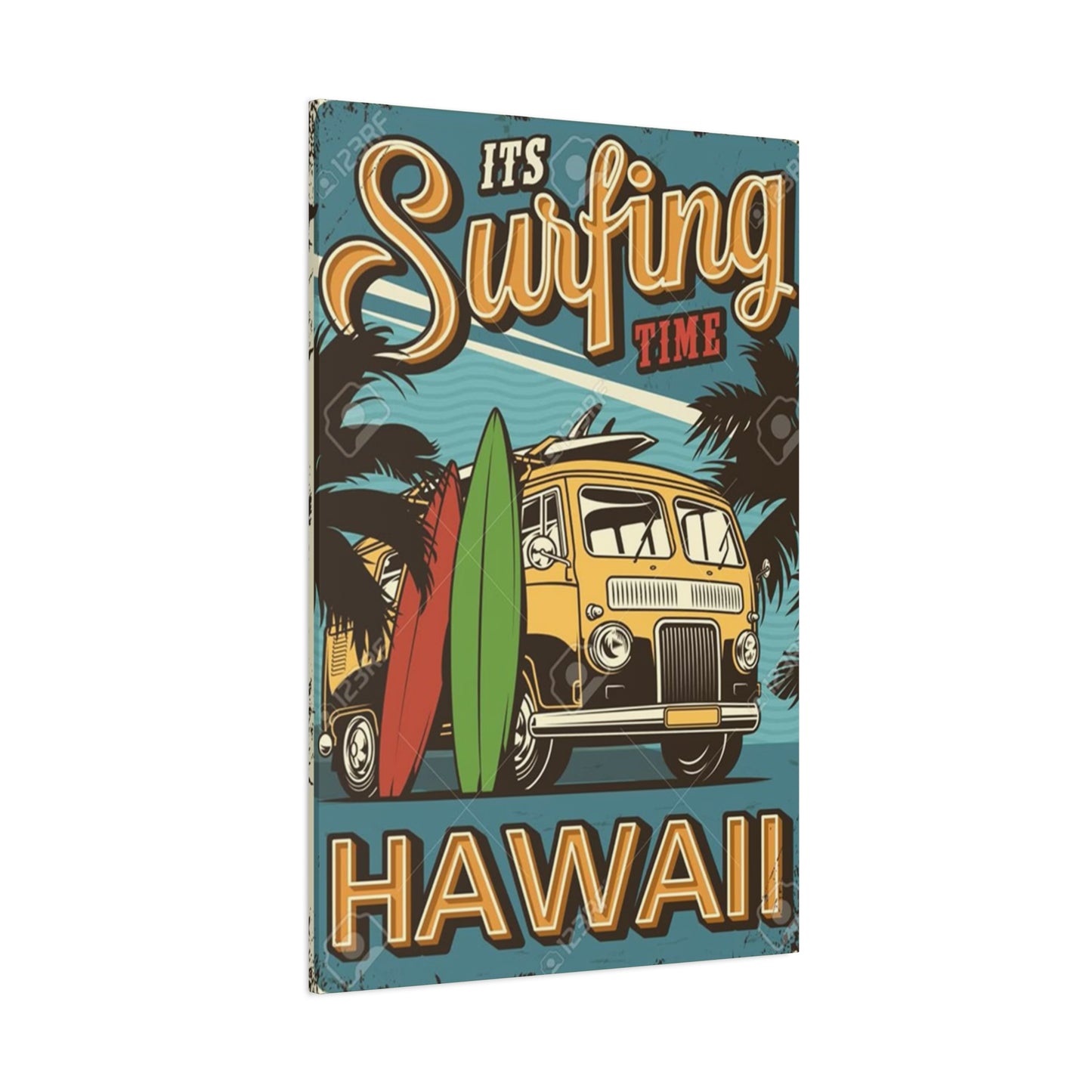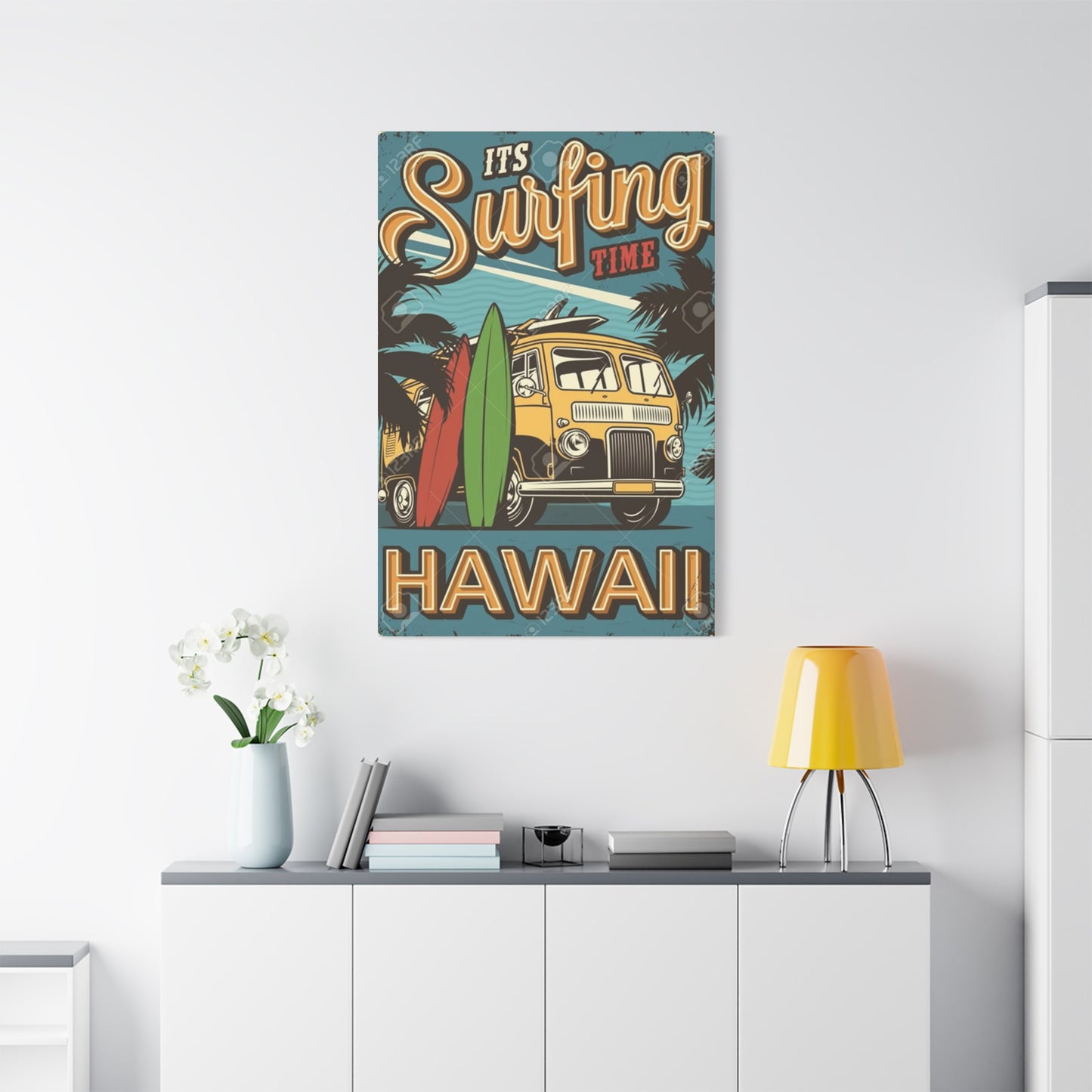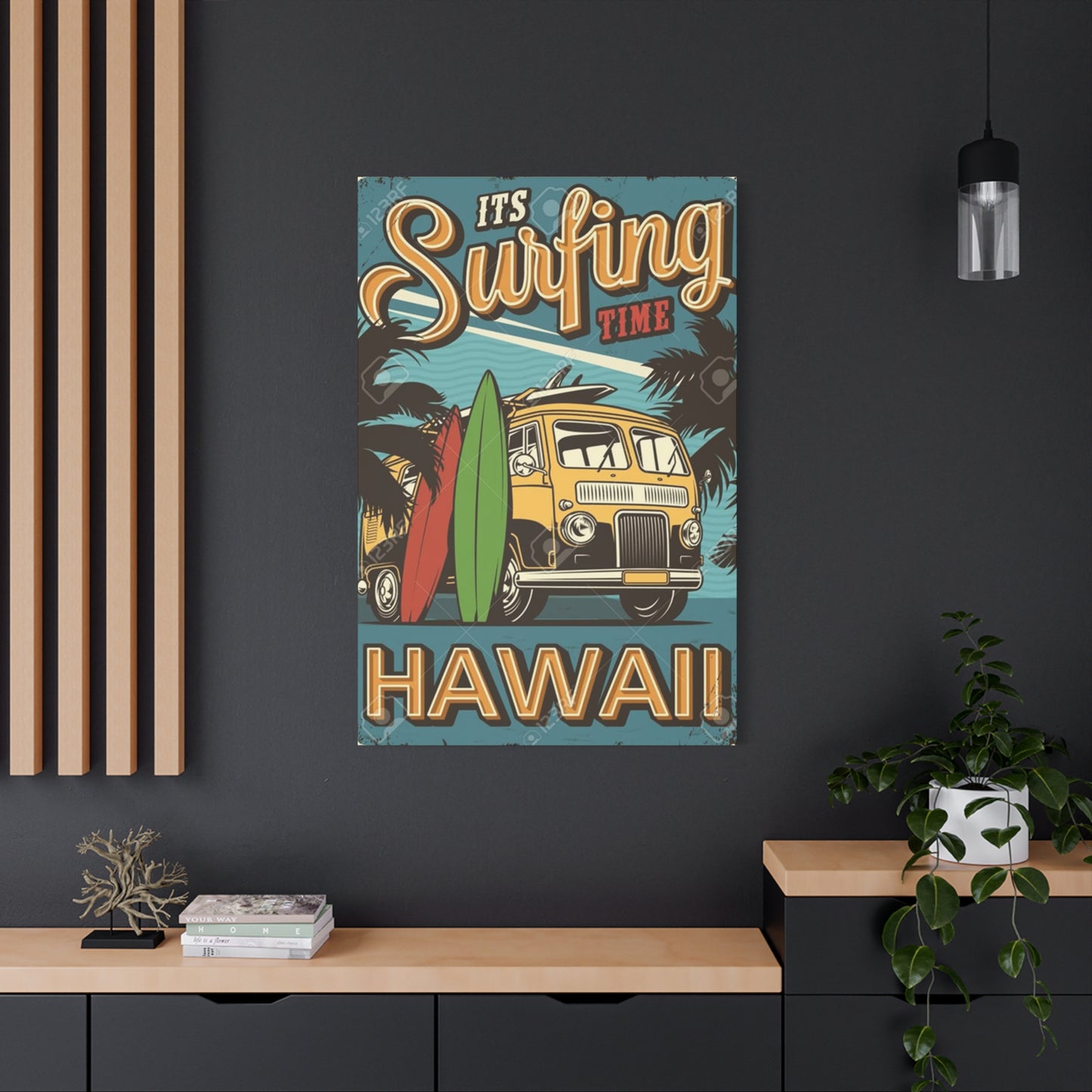Hawaii Surfing Wall Art: Bringing Ocean Paradise to Your Living Environment
The Hawaiian surfing tradition represents far more than a recreational activity; it embodies a spiritual connection between humanity and the ocean that has persisted for over a thousand years. When this profound relationship finds expression through visual artworks, it creates pieces that capture not merely the physical act of riding waves, but the deeper essence of what surfing means to Hawaiian culture and those who embrace this lifestyle worldwide.
Hawaiian surfing art serves as a bridge between ancient Polynesian traditions and contemporary artistic expression. The earliest inhabitants of the Hawaiian Islands viewed surfing as a sacred practice, with chiefs and commoners alike participating in rituals that honored the ocean's power. Today's artists draw upon this rich cultural heritage, creating works that reflect both historical reverence and modern interpretations of wave riding.
The spiritual dimension of surfing becomes evident in artworks that depict surfers in moments of perfect harmony with the waves. These pieces often showcase the meditative quality of waiting for the right wave, the split-second decision-making required during a ride, and the profound satisfaction that comes from successfully navigating ocean swells. Artists capture these ephemeral moments through various techniques, from realistic portrayals to abstract interpretations that focus on emotion rather than literal representation.
Contemporary Hawaiian surfing art frequently incorporates traditional Polynesian symbols and motifs, creating a visual dialogue between past and present. Tribal patterns, ocean creatures, and celestial bodies often appear alongside modern surfboard designs and contemporary surfing scenes. This fusion creates artworks that speak to both cultural authenticity and artistic innovation.
The color palettes used in Hawaiian surfing art typically reflect the natural beauty of the islands. Deep blues and turquoise tones represent the ocean in its various moods, while golden yellows and warm oranges capture the perpetual Hawaiian sunshine. These color choices aren't merely aesthetic decisions; they're deliberate attempts to transport viewers to the tropical paradise where surfing culture first flourished.
Artists working in this genre often emphasize the relationship between surfer and wave as a dance of mutual respect. The ocean isn't portrayed as something to be conquered, but rather as a partner in an eternal choreography. This perspective influences how waves are depicted – not as threatening forces, but as opportunities for connection and transcendence.
The therapeutic aspects of surfing also find expression in Hawaiian surf art. Many pieces convey the sense of peace and clarity that comes from time spent in the ocean. These artworks often feature solitary figures on surfboards, surrounded by vast expanses of water, suggesting the meditative qualities of the surfing experience.
Iconic Hawaiian Surf Scenes
Hawaii's diverse coastline provides an endless array of iconic surfing locations that have inspired artists for generations. Each beach and break offers unique characteristics that create distinct artistic opportunities, from the thunderous barrels of Pipeline to the gentle longboard waves of Waikiki.
Waikiki Beach remains perhaps the most recognizable surfing location in the world, and its gentle, rolling waves have been captured in countless artworks. Artists are drawn to the juxtaposition of urban development and pristine ocean conditions, creating pieces that celebrate both the accessibility of surfing at Waikiki and its role in introducing millions of people to Hawaiian surf culture. The iconic Diamond Head crater often appears in the background of these scenes, providing a dramatic geological anchor that emphasizes the natural beauty of the setting.
Pipeline on Oahu's North Shore represents the opposite end of the surfing spectrum, offering some of the most challenging and spectacular waves on Earth. Artists who tackle Pipeline scenes must capture not only the power and danger of these waves but also the incredible skill required to ride them successfully. These artworks often feature dramatic lighting effects, with sunlight filtering through massive tubes of water, creating cathedral-like scenes that emphasize the spiritual aspects of big-wave surfing.
Sunset Beach provides another iconic North Shore location that artists frequently explore. The beach's name reflects the spectacular evening light shows that occur there, and surf artists often capitalize on these natural lighting conditions to create works that combine surfing action with breathtaking atmospheric effects. The interplay between warm sunset colors and cool ocean tones creates natural color harmonies that enhance the emotional impact of these pieces.
Maui's Ho'okipa Beach Park offers unique artistic opportunities with its consistent trade winds and diverse surfing conditions. Artists often depict the interplay between windsurfers and traditional surfers at this location, creating dynamic compositions that showcase multiple forms of wave riding. The red dirt cliffs that frame Ho'okipa provide warm earth tones that contrast beautifully with the cool ocean colors.
Big Island locations like Laupahoehoe Point offer artists the opportunity to explore the relationship between volcanic activity and ocean sports. These scenes often feature dramatic black sand beaches and rocky coastlines that provide stark contrasts to the typical white sand beach imagery associated with Hawaiian surfing.
Each of these iconic locations has developed its own artistic vocabulary over time. Artists who specialize in specific breaks often develop signature techniques for capturing the unique characteristics of their chosen waves. This specialization has led to the emergence of location-specific artistic traditions that contribute to the broader tapestry of Hawaiian surf art.
The seasonal variations at these locations also provide artistic opportunities. North Shore winter swells create completely different scenes than summer conditions, and artists often explore these temporal changes to create series that document the evolving relationship between surfers and their environment throughout the year.
Surf Culture in Hawaiian Wall Art
Hawaiian surf culture encompasses far more than the act of riding waves; it represents a comprehensive lifestyle that includes music, fashion, food, language, and social customs. Wall art that captures this broader cultural context creates pieces that resonate with viewers who understand surfing as a way of life rather than simply a sport.
The aloha spirit, central to Hawaiian culture, finds expression in surf art through depictions of community gatherings, shared surf sessions, and intergenerational knowledge transfer. Artists often portray elder surfers teaching younger generations, emphasizing the importance of mentorship and cultural continuity within the surfing community. These scenes celebrate the inclusive nature of Hawaiian surf culture, where respect for the ocean and fellow surfers transcends age, skill level, and background.
Traditional Hawaiian values like malama aina (caring for the land) appear in surf art through environmental themes. Many contemporary pieces address ocean conservation, plastic pollution, and climate change impacts on surfing conditions. These artworks serve dual purposes as aesthetic objects and environmental advocacy tools, reflecting the surf community's deep connection to ocean health.
The concept of ohana (family) pervades Hawaiian surf culture and appears frequently in related artwork. Family surf sessions, multi-generational lineups, and community celebrations provide rich subject matter for artists seeking to capture the social dimensions of surfing. These pieces often emphasize the bonds formed through shared ocean experiences and the way surfing creates extended family networks that transcend traditional kinship structures.
Music and surfing maintain a symbiotic relationship in Hawaiian culture, and this connection often appears in surf art. Pieces might depict beach parties with ukulele players, sunrise surf sessions accompanied by Hawaiian chants, or evening gatherings where stories and songs are shared. These artworks acknowledge that surf culture includes soundtrack elements that enhance and complement the ocean experience.
The evolution of surfboard design represents another cultural element frequently explored in surf art. From ancient Polynesian olo boards to modern high-performance designs, surfboard development reflects technological progress and changing cultural values. Artists often create pieces that showcase this evolution, celebrating both traditional craftsmanship and contemporary innovation.
Hawaiian surf culture's influence on fashion and lifestyle choices provides additional artistic subject matter. The casual, ocean-friendly clothing associated with surf culture, the emphasis on natural materials and sustainable practices, and the integration of surfing schedules with daily life all offer opportunities for artists to explore cultural themes beyond wave riding itself.
Language plays a crucial role in Hawaiian surf culture, and artists often incorporate Hawaiian words and phrases into their works. Terms like pau hana (finished work) sessions, mahalo (thank you) moments, and descriptions of wave conditions in Hawaiian language add cultural authenticity to surf art while preserving linguistic traditions.
Waves and Movement in Surf Paintings
Capturing the dynamic movement of waves presents unique challenges and opportunities for artists working in the surf genre. Water's fluid nature requires technical approaches that can convey motion, power, and grace simultaneously. Successful surf paintings create visual rhythms that echo the ocean's natural patterns while suggesting the temporal aspects of wave formation and dissolution.
Traditional painting techniques must be adapted to represent water's transparency and reflectivity. Artists often employ layering methods that allow underlying colors to show through surface applications, mimicking how sunlight penetrates ocean water and reflects off underwater surfaces. These technical considerations require deep understanding of both artistic methods and oceanic behavior.
Brushwork in surf paintings often follows directional patterns that reinforce wave movement. Horizontal strokes might represent the forward motion of swells, while vertical applications could suggest the upward thrust of breaking waves. Circular brushwork can capture the spiraling motion within tube formations, while diagonal strokes emphasize the angular impact of waves against shorelines.
The challenge of depicting frozen moments within continuous motion leads many surf artists to explore sequential representation techniques. Some create series that show wave progression from formation to completion, while others incorporate multiple viewpoints within single compositions to suggest temporal progression. These approaches acknowledge that surfing experiences unfold over time rather than existing as static moments.
Color application in wave paintings must account for water's changing appearance under different conditions. Deep ocean swells might be rendered in dark blues and purples, while shallow water breaking over reefs could incorporate turquoise and aqua tones. Foam and spray require careful attention to value relationships, often using pure whites and light grays to suggest the aerated water created by wave action.
Texture becomes crucial in conveying wave energy and character. Smooth, glass-like surfaces suggest perfect conditions and gentle swells, while rough, chaotic textures indicate powerful, challenging waves. Artists develop personal vocabularies of textural techniques that allow them to communicate specific wave qualities to viewers who understand surfing conditions.
The integration of surfers into wave paintings requires careful consideration of scale and proportion relationships. Human figures must appear appropriately sized relative to wave dimensions, which often means depicting surfers as relatively small elements within larger compositions. This scale relationship emphasizes both the power of natural forces and the courage required to engage with them.
Light effects in wave paintings offer opportunities to create drama and atmosphere. Backlighting can create silhouette effects that emphasize action and gesture, while side lighting reveals wave texture and three-dimensional form. Artists often study actual surfing conditions to understand how light interacts with water under different circumstances.
Best Hawaii Surfing Art for Walls
Selecting optimal Hawaiian surfing artwork for residential or commercial environments requires consideration of multiple factors including scale, color harmony, subject matter, and viewing context. The most effective pieces enhance their surroundings while maintaining their individual artistic integrity and cultural authenticity.
Large-scale panoramic compositions work exceptionally well in open living areas where they can serve as focal points without overwhelming other design elements. These pieces often feature expansive ocean views with multiple surfers or comprehensive beach scenes that provide viewers with immersive experiences. The horizontal orientation of many surf scenes naturally complements contemporary architectural features and furniture arrangements.
Vertical compositions offer alternatives for narrower wall sections or areas where height emphasis is desired. These pieces might focus on single waves or individual surfers, using the vertical format to emphasize the dramatic height of large swells or the graceful lines of a surfer's stance. Vertical surf art can create striking visual anchors in hallways, bedrooms, or office environments.
Color coordination between artwork and existing environmental elements ensures visual harmony while allowing the surf art to enhance rather than compete with surrounding design choices. Pieces that incorporate earth tones alongside ocean blues can bridge the gap between natural and manufactured elements in contemporary living situations. Sunset scenes provide warm color palettes that complement wooden furnishings and natural textiles.
Subject matter selection should reflect the intended atmosphere of the environment. Energetic action scenes featuring large waves and dramatic surfing maneuvers create excitement and energy, making them suitable for social areas, exercise rooms, or creative workplaces. Calmer scenes depicting peaceful dawn patrols or meditative solo sessions work well in bedrooms, studies, or meditation areas.
The artistic style significantly impacts how surf art functions within different environments. Photorealistic pieces provide detailed documentation of actual surfing experiences, while abstract interpretations offer more flexibility in color coordination and emotional interpretation. Impressionistic works balance recognizable subject matter with artistic interpretation, making them versatile choices for various design contexts.
Lighting considerations affect how surf art appears throughout different times of day and under various illumination conditions. Pieces with strong value contrasts maintain visual impact under different lighting situations, while works that rely heavily on subtle color relationships might require consistent lighting to maintain their intended effect.
Framing choices influence how surf art integrates with surrounding environments. Natural wood frames can emphasize the organic connections between surfing and nature, while metal frames might complement contemporary design elements. Some pieces work effectively without traditional frames, using gallery-style mounting that emphasizes the artwork's contemporary relevance.
The emotional resonance of surf art varies significantly between different pieces and viewers. Artworks that evoke personal surfing memories or aspirations create stronger connections with viewers who have ocean experience, while pieces that emphasize universal themes like freedom, adventure, or natural beauty can appeal to broader audiences regardless of surfing background.
Colors of Hawaiian Surf Art
The color palette associated with Hawaiian surf art draws directly from the natural environment of the islands, creating visual vocabularies that transport viewers to tropical ocean settings while reflecting the diverse atmospheric and oceanic conditions found in Hawaiian waters. These color choices aren't arbitrary aesthetic decisions but deliberate attempts to capture the unique optical qualities of Hawaiian marine environments.
Ocean blues in Hawaiian surf art encompass an extensive range from the deep navy tones of offshore waters to the brilliant turquoise of shallow reef areas. Artists must understand how water depth, bottom composition, and lighting conditions affect perceived ocean colors. Deep channel waters between islands often appear nearly black in certain lighting, while the same areas might glow with phosphorescent blues during sunrise or sunset conditions.
The interplay between sky and water colors creates natural harmonies that surf artists frequently exploit. Hawaiian skies contribute everything from pale dawn pastels to dramatic sunset oranges and purples. These atmospheric colors reflect into ocean surfaces, creating complex color relationships that change throughout the day and with weather conditions. Successful surf art captures these temporal color variations to suggest specific times and moods.
Tropical vegetation provides green elements that frame many surf scenes while connecting ocean imagery to land-based environments. Palm fronds, pandanus trees, and tropical understory plants contribute various green tones that complement ocean blues while suggesting the complete island environment. These botanical elements often appear as compositional frames or background elements that establish geographic context.
Sand colors vary significantly across different Hawaiian beaches, from the pure white calcium carbonate sands of Kailua to the black volcanic sands of Punaluu. Artists working with specific locations must accurately represent these substrate colors to maintain geographical authenticity. Sand also provides neutral tones that balance the intensity of ocean and sky colors.
Surfboard colors offer opportunities for artists to introduce additional chromatic elements into their compositions. Traditional natural wood tones connect contemporary surfing to its Polynesian origins, while modern synthetic boards provide opportunities for bright accent colors that can enhance compositional dynamics. Many surf artists use surfboard colors strategically to guide viewer attention and create visual focal points.
Foam and spray colors require subtle handling to maintain realism while providing necessary value contrasts. Pure white foam appears only under specific lighting conditions, while most spray and foam incorporates reflected colors from surrounding elements. Understanding these reflected color relationships allows artists to create convincing water effects that integrate naturally with their overall color schemes.
Sunset and sunrise conditions provide opportunities for warm color dominance that contrasts dramatically with typical cool ocean tones. Golden hour lighting creates orange and pink reflections that transform ocean surfaces while providing romantic or spiritual atmospheres. Many Hawaiian surf artists specialize in these dramatic lighting conditions because they offer both visual impact and emotional resonance.
Seasonal color variations reflect changing weather patterns and ocean conditions throughout the Hawaiian year. Winter storms can create gray and purple skies that dramatically alter the typical bright tropical palette, while summer trade wind conditions might emphasize crisp blues and whites. Artists who work in series often explore these seasonal changes to document the full range of Hawaiian surfing environments.
Capturing Energy in Surf Art
The kinetic energy inherent in surfing presents both the greatest challenge and the most rewarding opportunity for artists working in this genre. Successfully capturing movement, power, and grace requires technical skills that go beyond basic representation to suggest the temporal and dynamic aspects of wave riding experiences.
Dynamic composition techniques help artists convey movement even within static media. Diagonal lines suggest motion and instability, while curved forms echo wave shapes and surfing gestures. The placement of visual elements along diagonal axes creates implied movement that guides viewer attention through compositions while suggesting the flowing nature of surfing action.
Gestural drawing techniques, often associated with figure drawing, prove essential for capturing surfing poses and wave formations. Quick, confident marks can suggest movement more effectively than labored, detailed rendering. Many successful surf artists develop gestural vocabularies that allow them to communicate specific actions and attitudes through economical mark-making.
Value relationships play crucial roles in suggesting three-dimensional form and movement within surf art. Strong light-dark contrasts can freeze dramatic moments while suggesting the power behind surfing actions. Gradual value transitions might indicate smooth, flowing movements, while abrupt value changes suggest sudden impacts or directional changes.
Color temperature variations contribute to energy perception within surf artworks. Cool colors often recede visually while warm colors advance, allowing artists to use temperature contrasts to suggest depth and movement. A warm-colored surfer against cool ocean backgrounds creates natural focal emphasis while suggesting the human energy engaging with natural forces.
Brushwork and mark-making techniques directly influence how viewers perceive energy within surf art. Bold, aggressive brushstrokes suggest power and excitement, while smooth, flowing applications indicate grace and control. Many surf artists develop signature mark-making approaches that become recognizable elements of their individual styles.
Scale relationships between surfers and waves communicate different types of energy and emotion. Small figures on massive waves emphasize natural power and human courage, while larger figure representations might focus attention on technique and skill. These scale choices significantly influence how viewers interpret the energy dynamics within surf scenes.
Sequential imagery techniques allow artists to suggest motion through time progression. Multiple exposure effects, motion blur suggestions, or compositional elements that imply before-and-after moments can create temporal narratives within single artworks. These approaches acknowledge that surfing energy unfolds over time rather than existing in isolated moments.
The integration of environmental energy elements enhances the overall dynamic quality of surf art. Wind-blown spray, streaming hair, and flowing clothing all contribute to movement suggestions that support primary surfing actions. These secondary elements often provide crucial visual information about conditions and energy levels within depicted scenes.
Surfboards as Art Subjects
Surfboards function as both practical tools and cultural artifacts within Hawaiian surfing traditions, making them compelling subjects for artistic exploration. Their evolution from ancient Polynesian wooden boards to contemporary high-performance designs reflects technological progress, cultural change, and individual expression within the surfing community.
Historical surfboard designs provide connections to Polynesian cultural origins and traditional craftsmanship techniques. Ancient Hawaiian boards, carved from native woods using traditional tools, represent sophisticated understanding of hydrodynamics and wave behavior. Artists who depict these traditional designs often emphasize their organic forms and natural materials, creating works that celebrate both functional excellence and cultural heritage.
Contemporary surfboard designs offer opportunities to explore modern materials, manufacturing techniques, and performance innovations. Fiberglass and foam constructions allow for precise shaping and colorful surface treatments that provide rich visual possibilities. Artists might focus on the technical aspects of modern board design or use contemporary boards as platforms for exploring color, pattern, and surface texture relationships.
Surfboard art extends beyond representation to include actual decorated surfboards created as functional artworks. Many artists work directly on surfboard surfaces, creating pieces that serve dual purposes as rideable equipment and visual art objects. These functional artworks must balance aesthetic considerations with performance requirements, leading to unique design challenges and creative solutions.
The relationship between board design and surfing performance provides subject matter for artists interested in technical aspects of wave riding. Different board shapes, sizes, and configurations enable different types of surfing, and artists might explore these relationships through comparative studies or detailed technical illustrations that celebrate both form and function.
Surfboard collections and quiver displays offer compositional opportunities for artists interested in serial imagery or installation concepts. Multiple boards arranged in racks or displayed individually can create rhythmic visual patterns while suggesting the variety and specialization within contemporary surfing equipment. These arrangements might emphasize similarities between designs or celebrate diversity within board collections.
Damaged or retired surfboards provide emotional subject matter that explores themes of use, aging, and memory within surfing culture. Dinged, sun-faded, or broken boards carry stories of surfing adventures and can serve as metaphors for experience and time passage. Artists working with these subjects often emphasize textural qualities and weathering patterns that document boards' service histories.
The craftsmanship involved in traditional board shaping offers opportunities for artists to explore maker culture and artisanal traditions. Depictions of shapers at work, traditional tools and techniques, and the transformation of raw materials into finished boards can celebrate the human skills and knowledge that create functional surfing equipment.
Environmental considerations in surfboard construction and disposal provide contemporary subject matter for socially conscious surf artists. Explorations of sustainable materials, recycling programs, and environmental impact awareness reflect the surfing community's growing environmental consciousness and provide platforms for advocacy through artistic expression.
Using Surf Art to Decorate Your Home
Integrating Hawaiian surf art into residential environments requires thoughtful consideration of how these pieces will function within daily living situations while maintaining their cultural authenticity and artistic impact. Successful integration enhances both the artwork and the living environment through complementary relationships.
Living room installations often benefit from large-scale surf art that can serve as conversational focal points while establishing atmospheric themes for the entire area. Pieces positioned above mantels, sofas, or entertainment centers should relate proportionally to furniture scales while providing visual anchors that organize surrounding design elements. The horizontal orientation of many surf scenes naturally complements contemporary furniture arrangements and architectural features.
Bedroom environments call for surf art that promotes relaxation and positive associations with ocean experiences. Dawn patrol scenes, peaceful lineup moments, or meditative solo surfing images can enhance sleep environments while maintaining connections to surfing aspirations. Cooler color palettes work particularly well in bedroom settings, providing calming influences that support rest and recovery.
Kitchen and dining areas benefit from surf art that incorporates social aspects of surfing culture. Group surf sessions, beach gatherings, or post-surf meal scenes can enhance spaces associated with social interaction and nourishment. These pieces might include elements of Hawaiian food culture or community celebrations that connect surfing to broader lifestyle themes.
Home office environments can benefit from surf art that provides inspirational or motivational influences without creating excessive distraction. Action scenes that suggest determination and skill, or peaceful ocean views that offer mental breaks from work pressures, can enhance productivity while maintaining visual interest. The key lies in selecting pieces that energize rather than overwhelm work-focused environments.
Bathroom installations offer unique opportunities for surf art integration, given the natural connection between water themes and bathroom functions. Smaller-scale pieces work well in these intimate environments, possibly focusing on wave details, foam patterns, or close-up surfing action that can be appreciated during brief viewing opportunities.
Hallway and transitional area applications allow for surf art series or sequential pieces that create narrative experiences as viewers move through homes. These installations might document different surfing locations, seasonal variations, or progression through surfing skill development. Linear arrangements work particularly well in corridor environments.
Children's room installations should emphasize positive, accessible aspects of surfing culture while avoiding potentially frightening wave imagery. Gentle beach scenes, colorful surfboard displays, or cartoon-influenced surf characters can introduce young people to surfing themes while maintaining appropriate emotional tone for youth environments.
The integration of lighting systems enhances surf art impact while protecting pieces from damage. Picture lighting, track systems, or natural light positioning should enhance color and detail visibility without creating harmful UV exposure or heat buildup that might damage artworks over time.
Famous Hawaiian Surf Artists
The tradition of Hawaiian surf art encompasses generations of artists who have developed distinctive approaches to capturing ocean experiences and surfing culture through visual media. These artists have created bodies of work that document the evolution of Hawaiian surfing while establishing artistic traditions that continue to influence contemporary practitioners.
Rick Rietveld stands among the most recognized contemporary Hawaiian surf artists, known for his ability to capture both the power of large waves and the intimate relationship between surfers and ocean environments. His work demonstrates technical mastery of water representation while maintaining emotional authenticity that resonates with surfing communities worldwide. Rietveld's compositions often emphasize the dramatic scale relationships between human figures and natural forces.
Phil Roberts has created an extensive body of work that celebrates the lifestyle aspects of Hawaiian surfing culture alongside action-oriented wave riding scenes. His pieces frequently incorporate environmental elements that establish geographic and cultural context while maintaining focus on surfing as a central theme. Roberts' use of warm color palettes reflects the tropical environment while creating emotionally inviting artworks.
Roy Tabora brings fine art training to surfing subjects, creating technically sophisticated pieces that appeal to both surfing enthusiasts and traditional art collectors. His work demonstrates how surfing themes can be elevated to museum-quality standards while retaining authenticity and cultural relevance. Tabora's attention to atmospheric effects and lighting creates pieces with broad aesthetic appeal.
Drew Brophy represents a contemporary approach that incorporates street art influences and modern design sensibilities into traditional surf art themes. His work often features bold graphics, contemporary color palettes, and stylized representations that appeal to younger generations while maintaining connections to surf culture roots. Brophy's versatility extends to various media and applications beyond traditional gallery presentations.
Wyland, while known primarily for marine life artwork, has created significant contributions to surf art through pieces that combine ocean conservation themes with surfing imagery. His large-scale murals and public art installations have brought surf-related imagery to audiences beyond traditional surf communities while promoting environmental awareness.
The influence of earlier artists like Eugene Savage, who documented Hawaiian scenes during the territorial period, continues to inform contemporary surf art development. These historical perspectives provide baselines for understanding how surfing representation has evolved alongside changes in surfing culture and artistic techniques.
Local Hawaiian artists who may not have achieved international recognition often create the most culturally authentic surf art because of their direct connections to island communities and surfing traditions. These artists contribute to ongoing cultural documentation while maintaining artistic traditions that reflect genuine island experiences rather than outsider interpretations.
The emergence of female surf artists has brought new perspectives to this traditionally male-dominated field. Artists like Camille Fontaine and others have introduced different viewpoints on surfing culture while expanding the range of experiences and emotions explored through surf art.
Contemporary digital artists are creating new forms of surf art that incorporate motion graphics, interactive elements, and social media integration. These approaches expand the definition of surf art while reaching younger audiences who engage with visual culture through electronic media.
The History of Surfing in Art
The artistic documentation of surfing extends back to the earliest European contact with Hawaiian culture, providing a visual record of how this practice has been perceived, romanticized, and interpreted by artists from diverse cultural backgrounds over more than two centuries of cross-cultural encounter and exchange.
Early European artists who visited Hawaii during the late eighteenth and early nineteenth centuries created some of the first visual records of surfing practices. These works, often created by expedition artists accompanying exploratory voyages, provide valuable historical documentation while reflecting the cultural perspectives and artistic conventions of their creators. The exotic nature of surfing, from European viewpoints, led to artistic interpretations that emphasized the unusual and spectacular aspects of wave riding.
The romanticization of Hawaiian culture during the nineteenth century influenced how surfing was depicted in art created for mainland American and European audiences. Artists often portrayed surfing as a noble savage activity, emphasizing the harmony between indigenous peoples and natural environments while sometimes overlooking the sophisticated technical and cultural aspects of traditional surfing practices.
The revival of surfing during the early twentieth century, largely through the efforts of Duke Kahanamoku and other Hawaiian ambassadors, coincided with increased artistic attention to surfing themes. This period saw the development of more technically accurate and culturally informed surf art as artists gained better understanding of surfing practices and their cultural significance.
The emergence of surf culture in California during the 1950s and 1960s created new artistic opportunities and markets for surf-themed artworks. California artists began developing distinctively different approaches to surf art that reflected local conditions, cultural perspectives, and artistic traditions. This geographic expansion led to regional variations in surf art styles and themes.
The commercialization of surfing during the latter twentieth century influenced surf art development through sponsorship opportunities, commercial applications, and expanded market demand. Artists could now make livings creating surf art for commercial reproduction, leading to both increased production and concerns about artistic integrity within commercial contexts.
Contemporary surf art reflects global surfing expansion and cultural cross-pollination as artists from diverse geographic and cultural backgrounds contribute to surf art traditions. Australian, South African, European, and other regional approaches to surf art have enriched the overall artistic vocabulary while creating international dialogue about surfing experiences and representation.
The integration of surf art into mainstream art markets has elevated the status of surf-themed artworks while sometimes creating tensions between cultural authenticity and commercial appeal. Gallery representation, museum exhibitions, and art fair participation have brought surf art to broader audiences while raising questions about cultural appropriation and artistic integrity.
Digital technology has revolutionized surf art creation and distribution, allowing artists to reach global audiences while experimenting with new media and interactive formats. Online galleries, social media platforms, and digital printing technologies have democratized both art creation and consumption within surf art communities.
The environmental movement's influence on surfing culture has created new thematic directions in surf art, with many contemporary artists addressing ocean health, climate change, and sustainability issues through their work. These environmental themes reflect the surfing community's growing awareness of threats to ocean environments that support surfing activities.
Tropical Vibes in Surf Paintings
The integration of tropical environmental elements into surf paintings creates atmospheric contexts that transport viewers to Hawaiian paradise while establishing the geographic and cultural specificity that distinguishes Hawaiian surf art from other regional variations. These environmental elements serve both aesthetic and documentary functions within surf art compositions.
Palm trees represent perhaps the most iconic tropical element in surf paintings, providing vertical compositional anchors that contrast with horizontal ocean expanses while immediately establishing geographic context. Artists must understand palm tree varieties, growth patterns, and seasonal variations to create convincing tropical settings. Coconut palms, with their distinctive curved trunks and feathery fronds, appear most frequently in Hawaiian surf scenes.
Tropical flowering plants add color accents and seasonal references that enhance the paradise atmosphere associated with Hawaiian surfing. Plumeria, hibiscus, bird of paradise, and bougainvillea provide opportunities for warm color integration that complements cool ocean tones while suggesting the lush botanical environments that frame Hawaiian beaches.
Atmospheric conditions specific to tropical climates influence how artists approach lighting, weather effects, and seasonal variations within surf paintings. Trade wind patterns, tropical storm systems, and monsoon influences create unique cloud formations, light qualities, and atmospheric effects that distinguish Hawaiian settings from temperate surfing locations.
Beach vegetation beyond palm trees includes pandanus, ironwood, naupaka, and other salt-tolerant plants that create transition zones between terrestrial and marine environments. These botanical elements provide opportunities for artists to explore ecological relationships while creating compositionally rich foreground and background elements.
Volcanic landscapes visible from many Hawaiian surf breaks provide dramatic geological contexts that emphasize the islands' unique formation history. Artists might incorporate volcanic peaks, lava rock formations, or black sand beaches that reflect the ongoing geological processes that created Hawaiian surfing environments.
Traditional architectural elements like thatched huts, traditional Hawaiian structures, or historical buildings can provide cultural context that connects contemporary surfing to indigenous traditions. These elements must be handled sensitively to avoid stereotypical representations while acknowledging legitimate historical connections.
Tropical wildlife elements including seabirds, marine mammals, and tropical fish can enhance the biological richness suggested within surf paintings. These creatures provide opportunities for artistic detail work while emphasizing the ecological complexity of Hawaiian marine environments.
Light quality in tropical environments differs significantly from temperate regions due to latitude, atmospheric conditions, and reflective surfaces. Artists working with tropical themes must understand how equatorial sunlight interacts with ocean surfaces, vegetation, and atmospheric particles to create convincing tropical atmospheres.
Color saturation levels in tropical environments often exceed those found in temperate climates, requiring artists to work with more intense color relationships while maintaining visual harmony. The intensity of tropical colors can overwhelm compositions if not carefully managed through value relationships and complementary color strategies.
Seasonal variations in tropical environments provide opportunities for artists to explore different moods and conditions within Hawaiian surfing contexts. Wet and dry seasons create different vegetation appearances, while seasonal swell patterns affect both ocean conditions and surfing activities.
Combining Surf Art with Beach Decor
The integration of surf art within broader beach-themed decorative schemes requires careful consideration of how these artworks will function alongside other coastal design elements while maintaining their individual artistic integrity and avoiding clichéd tropical stereotypes that diminish both artistic and decorative impact.
Natural material choices in beach decor provide complementary contexts for surf art through shared organic origins and textural relationships. Driftwood frames, rattan furniture, woven fiber rugs, and stone accents create environmental continuity that supports surf art themes while avoiding artificial tropical pastiche that might compromise artistic credibility.
Color coordination between surf art and beach decor should emphasize natural relationships rather than forced matching that might limit artistic impact. Ocean blues, sand tones, and vegetation greens provide natural harmonies, while accent colors can be drawn from sunset palettes or tropical flower themes that appear in surf artworks.
Lighting design plays crucial roles in both surf art presentation and overall beach decor effectiveness. Natural light sources, when available, enhance both artistic colors and natural decorative materials. Artificial lighting should support rather than compete with surf art while creating atmospheric effects that enhance beach-themed environments.
Furniture selection can either complement or compete with surf art installations. Simple, clean-lined pieces allow surf art to function as primary visual focal points, while ornate or heavily patterned furnishings might create visual conflicts that diminish both artistic and decorative impact. Scale relationships between furniture and artwork require careful consideration.
Textile choices within beach decor should support rather than overwhelm surf art presentations. Natural fiber fabrics in neutral or complementary colors provide visual rest areas that allow surf art to maintain prominence while contributing to overall environmental cohesion. Patterns should be selected carefully to avoid competition with artistic compositions.
Plant selection for beach-themed environments can reinforce surf art themes through species choices that appear in artistic backgrounds or geographic references. However, actual plant care requirements must be considered alongside decorative goals to ensure sustainable indoor gardening practices.
Accessory objects within beach decor should be selected for their relationships to surf art themes rather than generic tropical associations. Surfboards, ocean specimens, or culturally authentic Hawaiian objects can reinforce artistic themes, while mass-produced tropical accessories might diminish the cultural authenticity that makes surf art meaningful.
Architectural elements within beach-themed environments should support rather than compete with surf art installations. Window treatments, ceiling fans, and structural modifications should enhance the overall environmental theme while providing appropriate contexts for artistic presentations.
The balance between themed decoration and artistic presentation requires careful attention to avoid overwhelming surf art with excessive decorative elements. Surf art often functions best within simplified environments that allow artistic qualities to dominate visual attention while supporting beach themes through subtle environmental cues.
Seasonal decoration changes within beach-themed environments can provide opportunities to refresh surf art presentations while maintaining overall thematic consistency. However, these changes should enhance rather than distract from permanent surf art installations.
Surfing and Nature in Hawaiian Art
The relationship between surfing and the broader natural environment of Hawaii provides rich thematic material for artists exploring the ecological, spiritual, and cultural connections that define authentic Hawaiian surfing experiences. This relationship extends far beyond simple ocean recreation to encompass complex interactions between human activities and island ecosystems.
Marine ecosystem representation in Hawaiian surf art acknowledges that surfing occurs within complex biological communities rather than empty ocean environments. Coral reefs, tropical fish populations, marine mammals, and oceanic bird species all contribute to the ecological contexts that support both surfing activities and artistic inspiration. Artists who include these elements create more complete environmental portraits while educating viewers about marine biodiversity.
Watershed connections between mountain environments and coastal surfing areas reflect the island geography that channels rainfall from volcanic peaks to ocean outlets. Artists might explore how terrestrial processes influence ocean conditions, creating works that connect surfing to broader environmental systems while emphasizing the interconnectedness of island ecology.
Final Thoughts
Hawaii surfing wall art is more than just a visual celebration of the ocean—it’s a lifestyle statement that brings the spirit of aloha, adventure, and natural beauty into your living environment. Whether you’re an avid surfer or simply inspired by the rhythm of the waves and the island way of life, this type of artwork infuses your space with energy, tranquility, and an unmistakable coastal vibe.
Capturing moments of surfers riding powerful waves against the backdrop of Hawaii’s breathtaking landscapes, these art pieces serve as a reminder of freedom, balance, and the raw power of nature. The fluid motion, tropical colors, and iconic imagery of beaches, boards, and blue skies bring warmth and vitality to any room. From living rooms and bedrooms to home offices or beach-themed lounges, Hawaii surfing wall art can instantly transform your space into a personal paradise.
One of the greatest strengths of this art style lies in its versatility. You can choose from vintage surf posters, photographic prints, modern graphic designs, or hand-painted canvases to match your décor. Pair it with natural textures like rattan, driftwood, or linen to fully capture the laid-back island aesthetic, or contrast it with contemporary furniture to create a bold, eclectic style.
Beyond aesthetics, Hawaii surfing wall art tells a story. It speaks to a deep connection with nature, a passion for movement, and the timeless allure of ocean life. It’s a perfect way to bring peace and positivity into your home—elements that are especially meaningful in today’s fast-paced world.
Ultimately, incorporating Hawaii surfing wall art is about more than décor—it’s about creating a sanctuary that reflects your love for the sea and the easygoing rhythm of island life. It’s a daily reminder to breathe deeply, live fully, and ride life’s waves with joy and courage.


















